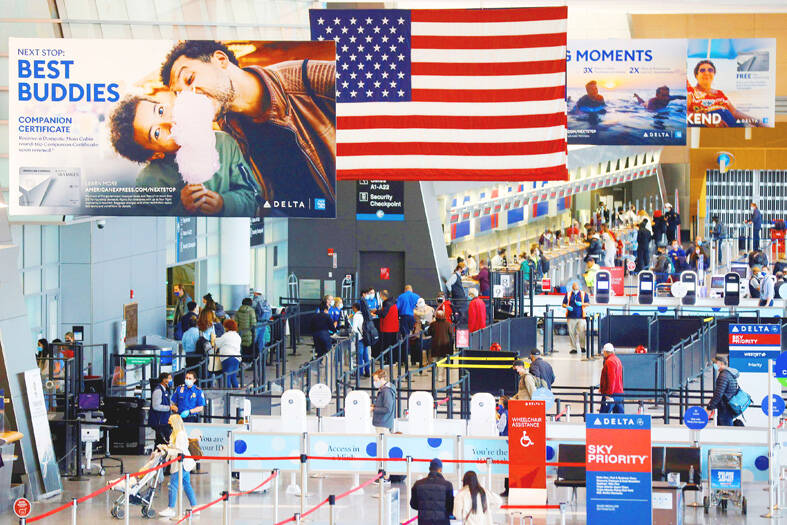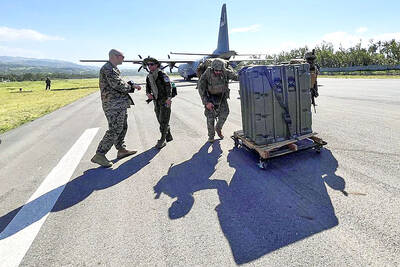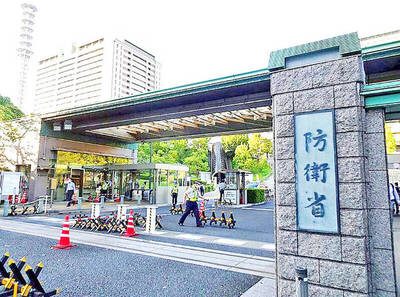Taiwanese flight carriers should consider launching direct flights to Washington and Boston to draw more international travelers from North America transferring through Taiwan Taoyuan International Airport, the Institute of Transportation think tank said in a study published last month.
The study analyzed data collected in 2019, and identified travelers between North America and Asia-Pacific countries as a potential source of transfer passengers at Taoyuan airport.
About 26.07 million passengers transferred via one of the seven key Asia-Pacific flight hubs: Taoyuan airport, Hong Kong International Airport, Incheon International Airport in South Korea, Japan’s Narita Airport, Chang-I Airport in Singapore, and Shanghai Pudong International Airport and Guangzhou Baiyun International Airport in China, the study found.

Photo: Reuters
Of those passengers, 7.25 million traveled between North America and Asia-Pacific countries, and mainly transferred through Incheon, Hong Kong or Taoyuan airports, the study shows.
It found that 2.36 million passengers transferred through Incheon airport, followed by about 2 million through Hong Kong airport and 1.3 million through Taoyuan airport.
The study also found that 98 percent of transfer passengers traveling between North America and the Asia-Pacific region were mainly from 15 locations: the US, Vietnam, Canada, China, the Philippines, India, Thailand, Japan, Indonesia, Singapore, Taiwan, Malaysia, Hong Kong, Australia and South Korea.
An analysis of the data showed that 1.83 million transfer passengers from the US were headed to Vietnam, accounting for 30.4 percent of the transfer passengers from the US on the routes between North America and the Asia-Pacific region.
Forty-seven percent transferred through Incheon airport, while 17 percent transferred through Narita and 16 percent through Taoyuan, the study shows.
Forty-eight percent of Chinese travelers to North America transited through Hong Kong airport, while 43 percent transferred through Incheon airport. Only 2 percent transferred through Taoyuan airport, as Beijing has yet to allow Chinese travelers to transfer flights in Taiwan, it said.
The study suggested that the government pursue transfer passengers on flights between the US and Vietnam.
“To attract more transit passengers, Taiwanese carriers can help facilitate flight transfers by launching new direct flights to North America and increasing flights to North American airports where direct flights are already available,” the study says.
The document identified several possible airports in the US for new direct flights, including Dulles International Airport in Washington, Logan International Airport in Boston, Hartsfield-Jackson Atlanta International Airport in Atlanta, Newark Liberty International Airport in Newark, Dallas-Fort Worth International Airport in Dallas and Saipan International Airport on Saipan Island, which is part of the Northern Mariana Islands, a US commonwealth.
Priority should be given to launching direct flights to Washington and Boston, as each destination has potential passengers of more than 200,000 per year, the study said.
The number of flights to Toronto Pearson International Airport in Canada, Daniel K. Inouye International Airport in Honolulu, Hawaii, Chicago O’Hare International Airport and John F. Kennedy International Airport in New York should be increased, as air passengers on these routes still have significant growth potential, the study added.

LOOKING NORTH: The base would enhance the military’s awareness of activities in the Bashi Channel, which China Coast Guard ships have been frequenting, an expert said The Philippine Navy on Thursday last week inaugurated a forward operating base in the country’s northern most province of Batanes, which at 185km from Taiwan would be strategically important in a military conflict in the Taiwan Strait. The Philippine Daily Inquirer quoted Northern Luzon Command Commander Lieutenant General Fernyl Buca as saying that the base in Mahatao would bolster the country’s northern defenses and response capabilities. The base is also a response to the “irregular presence this month of armed” of China Coast Guard vessels frequenting the Bashi Channel in the Luzon Strait just south of Taiwan, the paper reported, citing a

A total lunar eclipse, an astronomical event often referred to as a “blood moon,” would be visible to sky watchers in Taiwan starting just before midnight on Sunday night, the Taipei Astronomical Museum said. The phenomenon is also called “blood moon” due to the reddish-orange hue it takes on as the Earth passes directly between the sun and the moon, completely blocking direct sunlight from reaching the lunar surface. The only light is refracted by the Earth’s atmosphere, and its red wavelengths are bent toward the moon, illuminating it in a dramatic crimson light. Describing the event as the most important astronomical phenomenon

ENHANCING DETERRENCE: Stationing the missiles in Kyushu would allow Japan to cover waters near Taiwan and China’s coastal areas without any logistical difficulties Japan is to deploy extended-range anti-ship missiles at a Ground Self-Defense Force base in Kumamoto to bolster its defenses, the Yomiuri Shimbun reported on Saturday. The upgraded Type 12 surface-to-ship missile, with a range of more than 1,000km, would be capable of striking targets in the Taiwan Strait and along China’s coast. Originally limited to a few hundred kilometers, the Type 12 was recently modernized ahead of schedule. Deployment, initially slated for next year, has been accelerated after the upgrade was completed sooner than expected, the newspaper said. Stationing the missiles in Kyushu would allow Japan to cover waters near Taiwan and

The presence of Taiwanese politicians at China’s military parade tomorrow would send the wrong message to Beijing and the international community about Taiwan’s sovereignty and democracy, a national security official said yesterday. China is to hold the parade tomorrow to mark the 80th anniversary of Japan’s surrender in World War II. By bringing together leaders of “anti-West” governments such as Russia, North Korea, Iran and Belarus, the parade aims to project a symbolic image of an alliance that is cohesive and unbending against Western countries, the national security official said, speaking on condition of anonymity. Former Chinese Nationalist Party (KMT) chairwoman Hung Hsiu-chu